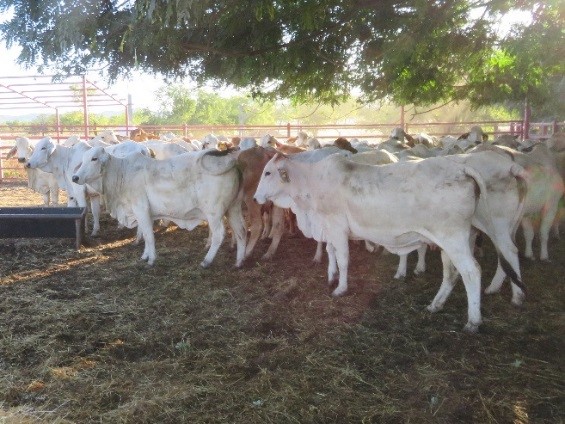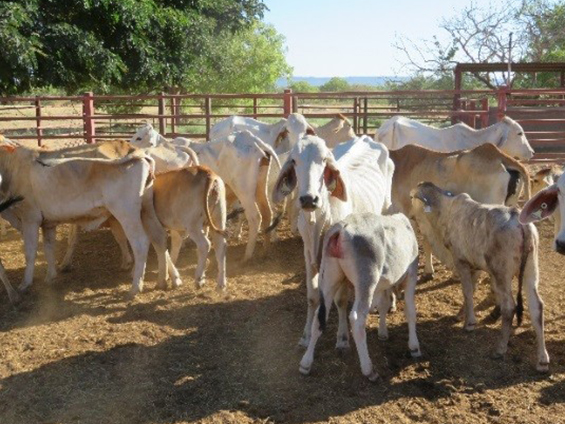New research on the benefits of phosphorus supplementation from Northern Territory Department of Primary Industry and Resources trial
Tim Schatz, Beef Production Systems Research Officer, Darwin
As we come to the time of year when cattle producers are thinking about wet season supplementation, it is timely to share the latest results from the NT DPIR phosphorus (P) supplementation trial at Kidman Springs (Victoria River Research Station). The trial is finding large benefits from P supplementation of breeding cattle on P deficient soils.
While the benefits of P supplementation are well known to some producers, it seems that many are not convinced enough to actually spend money on it, as sales figures show that adoption of P supplementation has been much lower than would be expected for the amount of P deficient country in northern Australia. Many previous trials have shown increased weight gain from feeding P supplements to growing animals during the wet season, but there haven’t been any published studies showing significant increases in pregnancy rates from feeding mineral (dry lick) P supplements to breeding cattle in northern Australia. As a result extension officers and supplement manufacturers have had to give estimates of the benefit that producers might expect without hard data to back them up. This may contribute to the low adoption of P supplementation. Hopefully the results from the Kidman Springs trial should help to change that.
The results emerging from the research at Kidman Springs are providing compelling information for producers with P deficient country. In the trial there are two treatment groups (P+ or P-) that have been managed in exactly the same way since weaning except that their mineral loose lick supplement either contains P (P+) or does not (P-). The composition of the lick fed to each treatment is shown in Table 1. The lick is fed year round in troughs under supplement sheds. The cattle graze in two adjoining paddocks of native pasture that are acutely P deficient (Colwell P <4 mg/kg). The treatments swap paddocks each year to minimise paddock effects. The research is finding large benefits from P supplementation (see Table 2). A summary of these benefits is:
- P+ maiden heifers were 66 kg heavier at the end of their first mating as two year olds
- Pregnancy rates were 10 per cent higher in P+ maiden heifers
- Re-conception rates were 25 per cent higher in P+ first lactation heifers
- The average weight of P+ first lactation heifers was 120 kg higher when their calves were weaned
- The average weaning weight of calves was 34 kg heavier in the P+ treatment
- The overall mortality rate over the three years from weaning to 3.5 years old was seven per cent lower in the P+ treatment
- Preliminary economic evaluation shows that by spending an extra $41 per head on supplement over the first three years the P+ treatment has produced about $300 per head more so far. If the heavier weight of the females retained is also included then it works out to be around $513 more per head
While this trial is showing large benefits from P supplementation, the response will vary depending on the level of P deficiency in the soils on which cattle graze. Benefits of this scale may not be seen where P deficiency is not as severe. Producers can get soil tests done if they are not sure of the P status of different land types on their property. Soils with a Colwell P level of less than 4 mg/kg are considered to be acutely deficient, while 5 mg/kg is deficient and 6-8 mg/kg is marginal. However there are often different soil types in a paddock and animals graze selectively so may be able target forage with higher P levels. Therefore while soil testing can give an indication, it is not considered to be a definitive method of determining deficiency. Currently testing blood samples taken from growing animals (eg. 1-2 y.o) at the end of the wet season for Plasma inorganic Phosphorus (PiP) is considered to be the most reliable indicator of the P status of animals. However, as a rough guide, if your first lactation heifers look more like the ones in Figure 1 than Figure 2 then it is likely that they will benefit from P supplementation (unless you have a stocking rate problem).
It can be difficult to put supplements out during the wet season, but many producers have found innovative ways to do it and usually ‘where there is a will there is a way’. Some have supplement dumps in shipping containers or under tarps scattered around their properties. It is really up to individual producers to weigh up the costs and benefits in their particular situation. The Kidman Springs P research trial is providing them with new information to do this.
Wet season | Dry season | |||
|---|---|---|---|---|
P+ | P- | P+ | P- | |
Ridley Biofos MCP | 42% | 25% | ||
Salt | 50% | 73.5% | 40% | 65% |
Ammonium sulphate (Gran Am) | 7.5% | 7.5% | 10% | 10% |
Urea | 25% | 25% | ||
Limestone | 17.5% | |||
Table 1. The contents of the loose mix supplement fed in the trial.
P- | P+ | Difference | |
|---|---|---|---|
Weaning weight (kg) (at start of trial) | 175 | 175 | 0 |
Maiden heifer pre-mating weight (kg) | 238 | 270 | 32 |
Maiden heifer post mating weight (kg) | 327 | 392 | 65 |
Pre-calving weight (kg) | 324 | 393 | 69 |
Weight when calves weaned (kg) | 262 | 382 | 120 |
Maiden pregnancy percentage (%) | 60 | 70 | 10 |
Calf loss rate (%) | 22 | 21 | -1 |
1st lactation heifer pregnancy rate (%) | 5 | 30 | 25 |
Mortality rate to 3.5 y.o (%) | 8 | 1 | -7 |
Weaning weight of calves (kg) | 139 | 173 | 34 |
Table 2. Results from the Kidman Springs P supplementation trial.
Photos of the heifers in the trial

| 
|
| Figure 2: First lactation heifers in the P- treatment | Figure 3: First lactation heifers in the P+ treatment |
The trial is on-going and will compare the kilograms of calves weaned from each treatment over several years. For more information contact: Tim Schatz 08 89992332
Give feedback about this page.
Share this page:
URL copied!